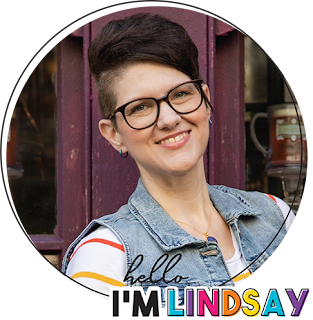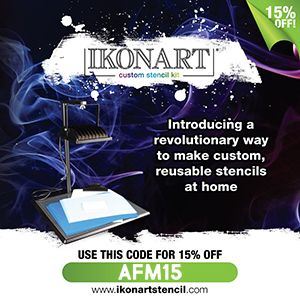Make a punny Wood-Burned Cheeseboard to use for holidays, family gatherings, or just for fun with help from Ikonart!
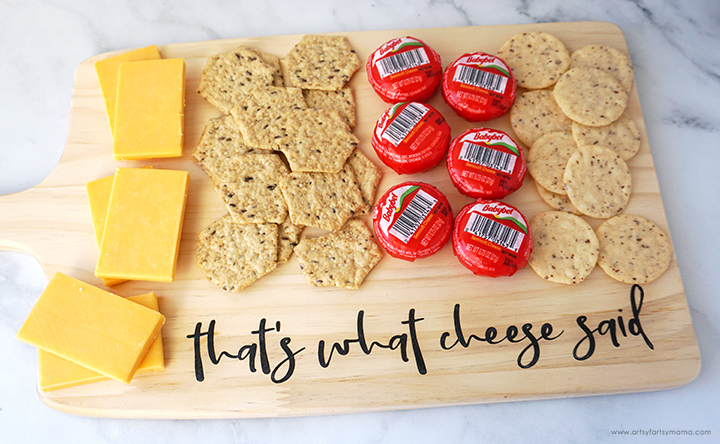
Charcuterie boards are all the rage, and I for one, am not at all sad about it. I mean, not only are they packed with cheese and other grazeable goodies, but you can make a custom board in practically no time using an Ikonart Stencil Kit. I had a great time making this punny Wood-Burned Cheeseboard to take to holiday parties and family gatherings, and I'm sharing the "That's What Cheese Said" design so you can make one, too!
New to making reusable stencils? Here's how to Get Started with Ikonart!

To make your own Wood-Burned Cheeseboard, you will need these supplies:
*Save 15% on Ikonart supplies when you shop with code AFM15
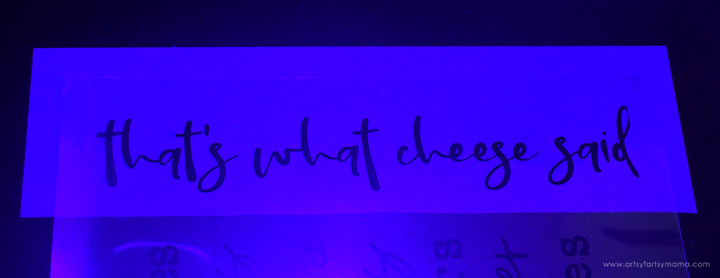
To make a stencil, you need to start with a printed design. Download the "That's What Cheese Said" Design (for personal use only) and size it to fit your cutting board. My printed design is about 10 inches wide. Print the design as dark as possible on either inkjet or laser Ikonart Printer Film.
The next step in the process is exposing the stencil film. Set up the exposure stand with UV LED Light by following the directions included in the kit. Ikonart Stencil Film is light sensitive, so be careful to keep it out of sunlight and bright lights before exposure. Cut a piece of the film the same size as the design print.
Lay the piece of film down on the base of the stand with the textured side facing up. Place the printed design on top of the stencil film, making sure it's right-side up - meaning that you should be able to read the words printed on the design.
Lastly, place the clear exposure sheet (found in the stencil film pack) on top and press it down well to seal the design tight against the stencil film. Turn the exposure light on and expose the film for 35 seconds.

The final step in the stencil-making process is to washout, or rinse, the stencil. Clip the exposed stencil film to the Ikonart clipboard with the shiny side (carrier sheet) touching the clipboard. Use the kitchen sink sprayer to rinse the stencil film with warm water until the design shows through and becomes completely clear. The washout process shouldn't take more than 3 minutes.
Gently blot the excess water from the stencil, and hang or lay the stencil flat to dry for about 45 minutes. When the stencil is dry, you shouldn't see any water spots or discoloration. Once the stencil is completely dried, place the it back on the exposure stand and expose it again for at least 2 minutes without the clear cover sheet. This extra exposure time will increase the durability of the stencil so you can get as much use out of it as possible.

Use a permanent marker and write "back" on the carrier sheet (shiny side) on the back of the stencil. Peel the carrier sheet away from the stencil and set it aside (don't throw it away).
Ikonart stencils work best on wood that is smooth. Go over the cutting board with 220 grit sandpaper and wipe it clean afterward with a damp cloth to remove any dust.
Place the stencil down on the board anywhere you'd like, and use a ruler to make sure it's on straight. I placed my stencil near the bottom right corner. Rub the stencil down evenly on the cutting board to help it stick to the surface and make sure to get rid of any air bubbles.
(imagine a record scratch sound effect here)
It was at this particular moment that I realized... the "d" at the end of my design had been cut off! I retraced my steps, and it actually happened in the printing process. While I could have easily started over with a new print and exposed a new stencil, I decided instead to show you that mistakes happen to everyone.
Supplies aren't cheap and/or easy to come by, so I think that it's important to share ways to work around "craft fails". You don't have to toss out your project because of a little mistake! As long as the stencil is still useable, there's a simple solution added in an extra step.
If you happen to notice the mistake right after printing on the Ikonart Printer Film, you can easily fix the problem by drawing the missing part right on the film using permanent marker. Then, expose the stencil as usual, and there shouldn't have any issues at all after that.
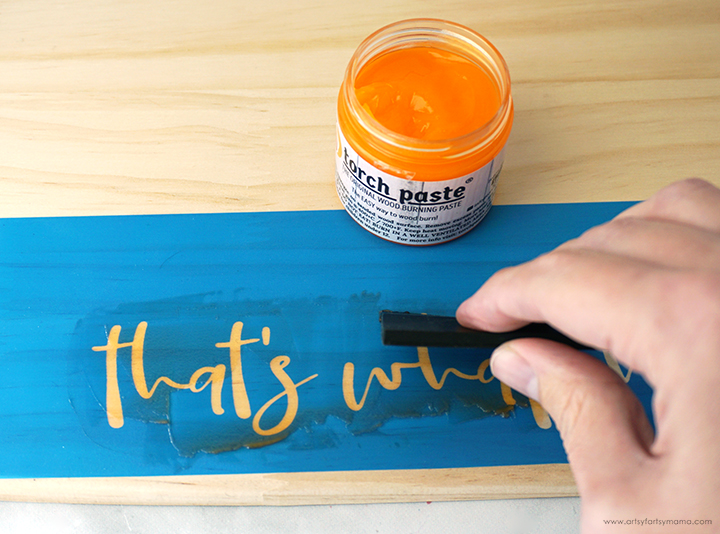
Wood-burning by hand can actually be a lot of fun, but Torch Paste makes it easier than ever to create a professional-looking wood-burned project with pretty much any image or text you want!
Use the squeegee to apply a thin layer of Torch Paste over the stencil. Be careful not to get any paste outside of the stencil area. If you feel like you need a little more wiggle room to work with, place some painters tape around the edges of the stencil. Scrape off any excess paste and put it back into the jar.

Slowly peel the stencil up, and pay attention to the design left behind on the cutting board. If you see any parts of the design that need a little more Torch Paste, lay the stencil back down and cover the area(s) again.

Obviously this won't be as perfect as when using a stencil, but it's a simple solution for this kind of problem!


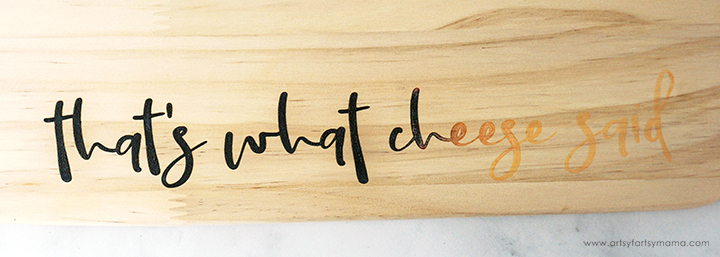
Apply heat to the pasted areas until you get the amount of burn you want. The longer you apply heat, the darker the burn effect. Again, just be sure to keep the heat gun moving during the process so that you don't make any scorch marks on the cutting board.


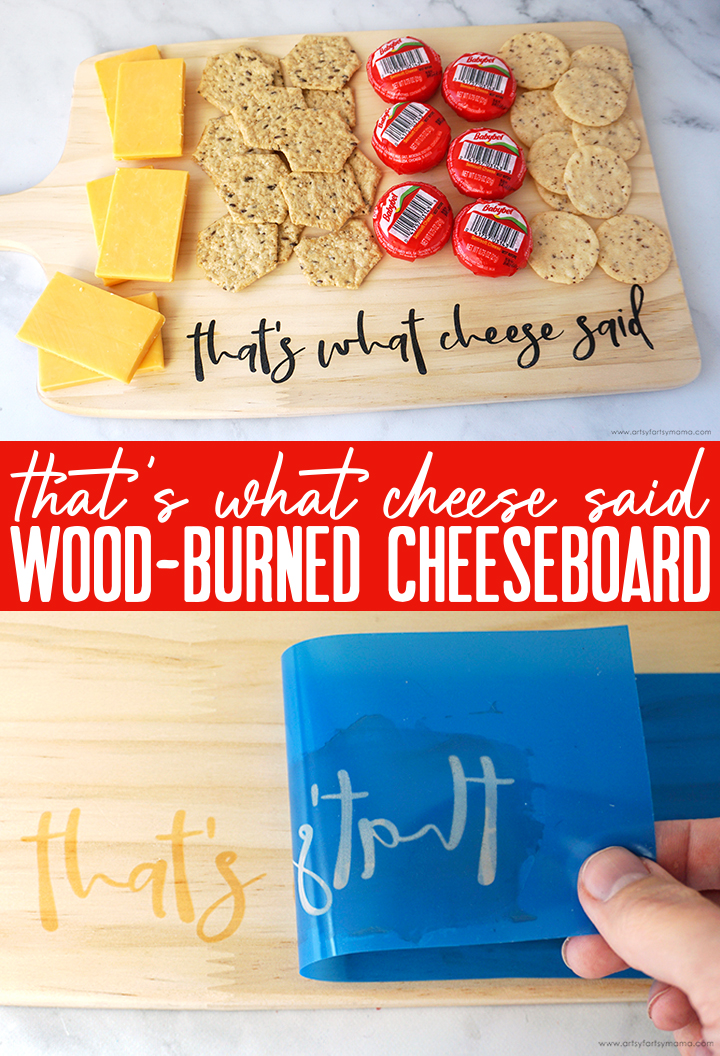

Once the stencil is completely removed from the cutting board, let the paste sit to dry for at least 2-3 minutes.
Use this drying time to wash the stencil. First, get the clipboard wet so your stencil doesn't stick to it. Place the stencil onto the clipboard with the textured side up, and lightly rub the stencil under cold running water to remove all of the paste.
Do not ever rub or scrub the adhesive side of the stencil, and NEVER use anything other than water to wash the stencils. To prevent the stencil from breaking down, don't ever leave the stencils to soak. It's totally normal for paints and pastes to leave a permanent stain on the stencils, so just make sure you get the mesh areas of the stencils as clean as you can.
Remove the stencil from the clipboard and lay it down with the adhesive-side up. While the stencil is still wet, place the carrier sheet onto the stencil so that the word “BACK” is readable. Hang or lay the freshly cleaned stencil flat to dry completely.

Are you ready for some Torch Paste magic?! Use a heat gun to apply heat to the design, moving the heat around continuously so that you don't burn one spot for too long. As you go over the pasted areas, the design will magically turn from a light orange to black.


Because the board is going to be used to hold all kinds of charcuterie (especially cheese), cover the cutting board with butcher block oil or sealant. I would recommend adding a multiple coats, letting the previous coat dry completely before adding another. Not only will this protect the wood, but it will help your project to last as long as possible.

I would not recommend cutting anything on the board because it will leave scratches behind. However, the board is food-safe, so use the board confidently for all of your cheesy charcuterie needs! To clean the board after use, gently wipe it down with a damp cloth. Do NOT put it in the dishwasher or immerse in water!
I had so much fun making this punny Wood-Burned Cheeseboard, and think it's the perfect charcuterie board for parties! I'd love to hear what you think about this project and what you would make with reusable stencils. If you've made wood-burned projects, I would absolutely love to see your creations! Share yours on Instagram, Facebook, or leave a comment/photo on the project pin on Pinterest! #AFMCrafts
Don't forget to Pin, Like, and Share!


